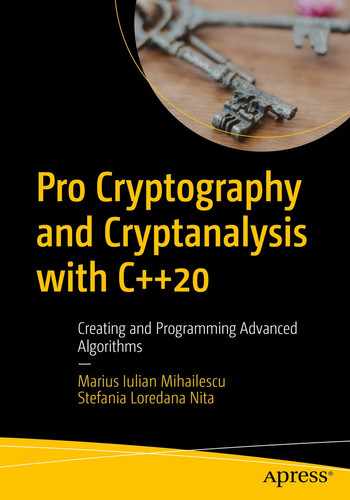Index
A
Ad-hoc techniques
American National Standards Institute (ANSI)
Attribute-based encryption (AE)
Authentication
Authentication protocols
B
Big data cryptography
CIA triad
cloud architecture
clouds
cryptographic techniques
nodes
VC
SeeVerifiable computation (VC
Big integer libraries
Bignum C++ Library
Boost library
GMP library
L3HARRIS Geospatial Solutions
LibBF Library
Matt McCutchen
ttmath:UInt<>
Big integers
adding 1
addition algorithm
multiplication
multiplyingOneDigit function
shifting to left
standard integer
transforming standard integer
Bignum C++ Library
Bigrams counting
Birthday problem
Boost library
Bootstrappable encryption schemes
Boson scattering
Botan
Brute-force attack
examples
generating strings
running
types
Buffer-overflow attack, execution
C
C++20
callable concepts
comparison concepts
core language concepts
features
feature testing
carries_dependency
no_unique_address
<compare> header
<concepts> header
<format> header
object concepts
Caesar cipher
C/C++ Libraries
CERT coding standards
automated detection process
compliant solutions
exceptions
identifiers
noncompliant code
related guidelines
risk assessment
rules
Chaos-based cryptography
chaotic maps
chaotic system vs. cryptographic algorithms
complex numbers
decryption process
discrete-time systems
encryption process
image encryption/decryption
Lyapunov exponent (LE)
periodical
practical implementations
SeePractical implementations
Rössler attractor
security analysis
Characters and Strings (STR)
Chinese Remainder Theorem (CRT)
Chi-squared statistic
encrypted text
output
Chosen-ciphertext attack (CCA)
Chosen-plaintext attack (CPA)
Cipher algorithms
Ciphertext-only attack (COA)
Closest vector problem (CVP)
Compilers
Complex numbers
Conditional probability
Correlation coefficient analysis
Counting monograms
Cryptanalysis
bigrams counting
Computer engineering and hardware
counting monograms
cryptography operations
history
informatics (computer science)
Linux hacking distributions
Mathematics
methodology
methods
modules
operations
penetration tools/frameworks
standards
steps
terms
theoretical vs. applied
trigrams counting
verification process
Cryptographic and cryptanalysis mechanism
Cryptographic keys
Cryptographic techniques
Cryptography
Caesar cipher implementation
decryption
encryption
execution
source code
codomain
communication process
definition
digital signature
domain
domains/codomains
electronic communication
elements
encryption/decryption
exchanging keys
functional diagram
hardness assumption
image
mechanisms
model/services
network security
public-key encryption scheme
RSA
secure communication process
standards
systems
Vigenére cipher implementation
algebraic description
source code
Cryptography algorithms
Cryptography Next Generation (CNG)
CrypTool (CT)
D
Data integrity
Declarations and initializations (DCL)
Differential analysis
Differential cryptanalysis
Digital signature
signing process
verification process
E
Elliptic-curve cryptography (ECC)
advantage
graphical content
group law
practical implementation
Boolean variable
FFE engine
main program
parts
Weierstrass equation
Elliptic Curve Diffie-Hellman (ECDH)
create keys
EC parameter
Elliptic Curve Digital Signature Algorithm (ECDSA)
Encryption/Decryption
Entropy
Euclidean Algorithm
Expressions (EXP)
F
Federal Information Processing Standards (FIPS)
Finite fields
basic notions
polynomial/euclidean algorithm
FIPS 140-2/140-3
Floating-point arithmetic
computations
data types
displaying
encryption/decryption mechanisms
floating point variable
functions
homomorphic encryption
precision
compiler
default
number of digits
output
representation
setprecision() function
professional libraries
range
Fully homomorphic encryption (FHE)
BFV scheme
C++
code
computing
encrypt/decrypt
noise budget
polynomials
SEAL library
second generation
third generation
uses
Visual Studio
Fully homomorphic encryption (FHE)
Functional encryption (FE)
G
Galois field
Gentry’s scheme
GNU Multiple Precision Arithmetic (GMP) library
Government Communications Headquarters (GCHQ)
H
Hash functions
keyed cryptographic
MD5
SHA-256
execution
source code
SHA-256 execution
unkeyed cryptographic
uses
Homomorphic encryption (HE)
classes
formal aspects
operations
I, J
Identity-based encryption (IE)
Information entropy analysis
Information security
cryptographic primitives
criteria
taxonomy
cryptography goals
authentication
confidentiality
data integrity
non-repudiation
physical document protection
physical format
security objectives
Information theory
Infrastructure-as-a-Service (IaaS)
Institute of Electrical and Electronical Engineering (IEEE)
Integer factorization problem
Integers (INT)
Integral cryptanalysis
attack
encryption
main program
theorems
International Association for Cryptologic Research (IACR)
International Organization for Standardization (ISO)
International Telecommunication Union (ITU)
Internet Architecture Board (IAB)
Internet Engineering Task Force (IETF)
Internet resources
Involutions
K
Key sensitivity analysis
Key space analysis
Known-plaintext attack (KPA)
L
Lattice-based cryptography
GGH encryption system
mathematical background
Learning with Errors (LWE)
Legendre symbol
output
source code
Lenstra Elliptic-Curve Factorization (L-ECC)
Leveled encryption schemes
LibBF Library
Linear and differential and integral cryptanalysis
Linear cryptanalysis
concatenation
performing
S-Boxes
simulation program
variables
Lyapunov exponent (LE)
M
Mathematical functions
involutions
one-to-one functions
one-way functions
permutations
trapdoor one-way functions
Matt McCutchen library
Memory Management (MEM)
Multi-party computation (MPC)
N
National Institute of Standards and Technologies (NIST)
Non-legal entity
Non-repudiation
Number theoretic transform (NTT)
Number theory
algorithms, in Z
algorithms Zm
integer Modulo n
integers
Legendre/JAccobi symbol
O
OpenSSL
binary
configure/install
Linux
Windows
openssl command
P, Q
Partial homomorphic encryption (PHE)
Permutations
Platform-as-a-Service (PaaS)
Practical implementations
cipher, chaos/fractals
encryption/decryption process
FractalCipherCrypto.h header file
main program
run
secure random number generator
compile/run
encryption.c source file
encryption.h header file
generation.c file
generation.h header file
main program
types
Private information retrieval (PIR)
Probability
birthday computation
computing
computing mean
CRT
Euclidean Algorithm
modular multiplicative inverse
output
standard deviation
variance output
Public encryption with keywords search (PEKS)
Public-key cryptography (PKC)
Public Key Cryptography Standards (PKCS)
extraction
generation
Public-key cryptosystem
decryption algorithm
encryption algorithm
key generation algorithm
Public-key encryption cryptosystem
R
Ring Learning with Errors cryptography (RLWE)
learning with errors
public-key encryption
quantum-resistant technique
ring-learning with errors
types
workflow
RLWE Homomorphic Encryption (RLWE-HE)
RLWE Key Exchange (RLWE-KE)
RLWE Signature (RLWE-S)
Rössler attractor
RSA
algorithm
cryptosystem
decryption
demonstration
encrypted text
prime number generator
S
S-Boxes
Searchable encryption (SE)
big data environment
components
entities
data owner
data user
server
guidelines
practical implementation
practical scheme
security characteristics
types
Secure coding checklist
Shor’s algorithm
Shortest independent vector problem (SIVP)
Shortest vector problem (SVP)
Social security numbers (SSNs)
Software-as-a-Service (SaaS)
Somewhat homomorphic encryption (SWHE)
Special Publications (SP)
Stream cryptography algorithms
Structured encryption (STE)
Symmetric searchable encryption (SSE)
T
Text characterization methods
Traditional encryption systems
Trapdoor information
Trigrams counting
U
Ubuntu system
V
Verifiable computation (VC)
compilation
example
files
main.cpp File
Merkle trees
run
tree.cpp File
tree_handling.h File
tree.h File
tree_node.cpp File
tree_node.h File
W, X, Y, Z
Weierstrass equation
..................Content has been hidden....................
You can't read the all page of ebook, please click here login for view all page.
